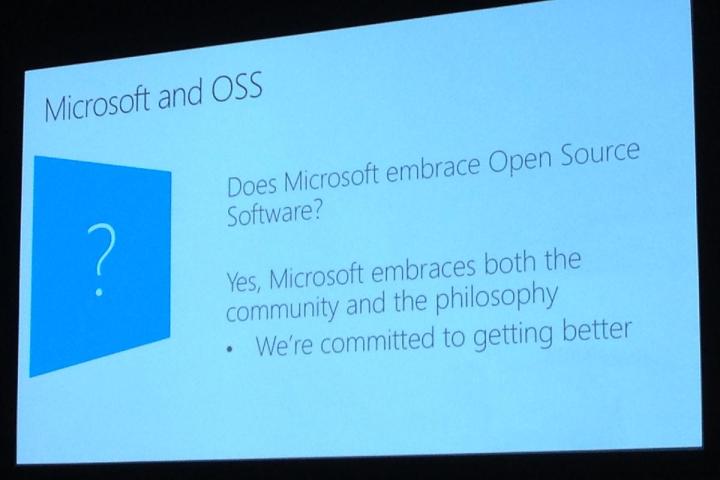
What we saw at BUILD 2015 was an entirely new direction. Never before has Microsoft so desperately wanted to gain back the favor of the development community. Rather than continue to close down the ecosystem, it’s finally relying on the huge developer base that already exists, as well as the software it has worked so hard to create.
Microsoft is bringing prolific development frameworks like C++ and .NET into the official fold by inviting apps powered by these platforms into the Windows Store. It’s been developing an increasingly large amount of software for competing platforms, like Mac OS X and Linux, as well as inviting developers from those platforms to create content for Microsoft platforms. Finally, a newly found devotion to open source licensing and active user feedback has led many to change their mind about the software giant. The days of “Micro$oft” may be over.
The expanded universe

A few months ago, Microsoft surprised everyone by releasing the .NET framework as open source software on Github. In doing so the company delivered 13 years of platform development into the hands of the eager developer community. Microsoft also promised Linux and Mac OS X runtime environments for .NET, and today we saw that goal realized, too.
BUILD also brought the announcement of a free, cross-platform development application called Visual Studio Code. It runs on both Mac OS X and Linux, and handles an immense number of programming languages. It even includes the Intellisense intelligent code completion tool that’s built into the full version of Visual Basic Studio. This isn’t a token attempt to bring Windows to other hardware, but a fully released tool meant to make Windows 10 development easy on any platform.
It’s clear that Microsoft is embracing a more modern development cycle.
It’s clear that Microsoft is embracing a more modern development cycle. If you’ve been using the Windows 10 Technical Preview, you know that new builds have been coming fast and hot, with lots of feedback during the process. Previous versions of Windows had very limited beta periods, open only to hardware managers and IT professionals that applied for the program and signed a non-disclosure agreement.
This time around, Microsoft has invited anyone and everyone to come try the newest OS, and did so quickly, putting out the first technical preview just days after the announcement in September of 2014. Since then, Microsoft has been open about changes made to builds, as well as the thought process that goes into each release. The development team has used A/B testing and an aggressive user feedback system to build a useful and responsive set of data about Windows 10 well before its release. This may be the closest we ever get to open source development of a Microsoft operating system.
Microsoft Office, a notoriously closed-off program, now has a full API for add-ins, so you can schedule an Uber ride right from your email client, or build an Excel spreadsheet inside your productivity software. That might not seem like revolutionary stuff with so much integration across other programs and platforms already, but it’s new territory for Microsoft.
Goodbye Ballmer, hello Nadella
It’s hard to look at the changes Microsoft has made in the last couple of years and not notice a distinct lack of Steve Ballmer. The former CEO of Microsoft stepped down in February of 2014, and Satya Nadella took over. In September, Windows 10 was announced, with a new release plan, and a return to the design values of Windows XP and 7.
Nadella’s background at Sun Microsystems, now free to reign, has kicked in.
If you want further proof that Nadella is at least partially responsible for the reworking of the Windows development cycle, you simply need to look at Ballmer’s opinions about Linux and Open Source software. During his time as Microsoft CEO, Ballmer compared Linux to cancer, stating his mistaken belief that “it attaches itself in an intellectual property sense to everything it touches.”
Nadella’s background at Sun Microsystems, now free to reign, has kicked in. He is making aggressive moves to modernize the software design strategy at Microsoft with which he’d become intimately familiar. Ballmer believed in cross-device development, but it was balanced by a hesitation to be open, as evidenced by Windows 8. His departure left an opening for a new approach.
The result has been a distinct change in the culture of Microsoft, from the music in advertisements, to the change in tone of the press conferences. There are living room scenes now, trendy music, and high-ranking employees in funky t-shirts.

Big changes for a big company
In the last year, Microsoft has made a public effort to fundamentally alter what we think we know about the brand. Some are small changes, like including more framework in the ecosystem, and producing more software for Linux and Mac OS X. Some are big moves, like turning .NET into open source software, or running a technical test for Windows 10 for over six months.
As much as the company loves to butt heads with Google, it’s clear that Microsoft is learning a lot from its competitor when it comes to corporate culture. The moves that other brands, from start-up to giant, have made an integral part of their business model are popping up all over Redmond, and it feels like the beginning of some really striking changes. Whether they fully commit to it or not, the first step in improving is recognizing that you’ve made a mistake, and taking steps to remedy the situation. In this case, Microsoft has made it clear it’s committed to being better.
Editors' Recommendations
- Microsoft may fix the most frustrating thing about Windows updates
- This new Windows 11 feature is a great addition for PC gamers
- Microsoft Teams is getting new AI tools — and they’re free
- PC gamers are flocking to Windows 11, new Steam survey says
- Microsoft may have known about Bing Chat’s unhinged responses months ago


